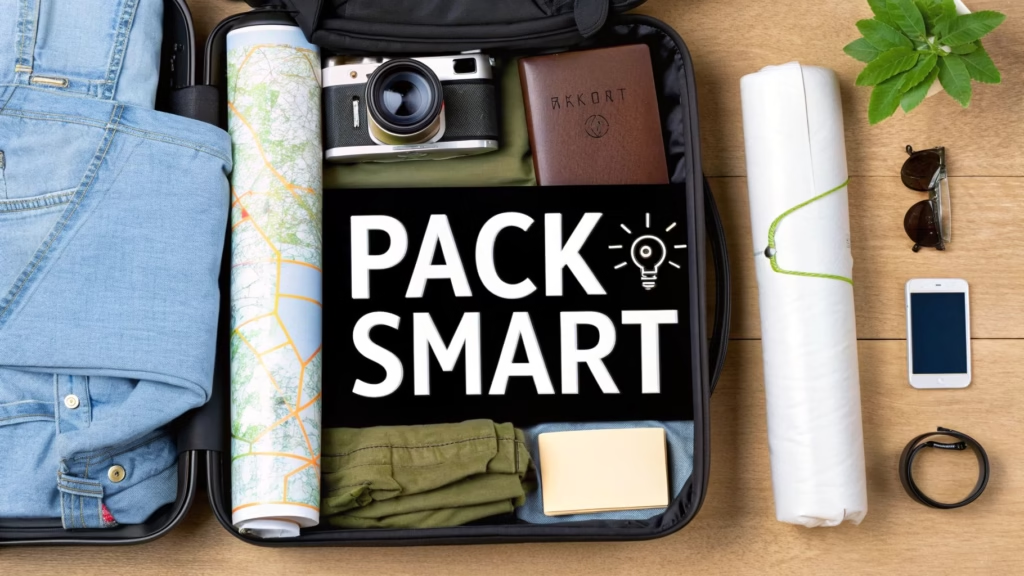Gearing Up for Your European Escape
This packing checklist for Europe covers seven essential items to streamline your trip, whether you’re an adventurer, culture enthusiast, or budget traveler. From staying connected with the right adapter to packing light with versatile cubes, these picks maximize your freedom and enjoyment. Discover how these essentials enhance safety, facilitate exploration, and simplify your packing, so you can focus on experiencing Europe. Check out gotravelyourself.com for more travel tips and resources.
1. Universal Travel Adapter
A universal travel adapter is an absolute must-have on any European packing checklist. This essential device allows you to connect your electronic devices, like phones, laptops, and cameras, to different types of electrical outlets found throughout Europe. Most European countries use Type C, E, or F sockets with a 230V supply, which differs from outlets in countries like the US, UK, or Australia. Without a travel adapter, you’ll find yourself unable to charge your devices and stay connected.
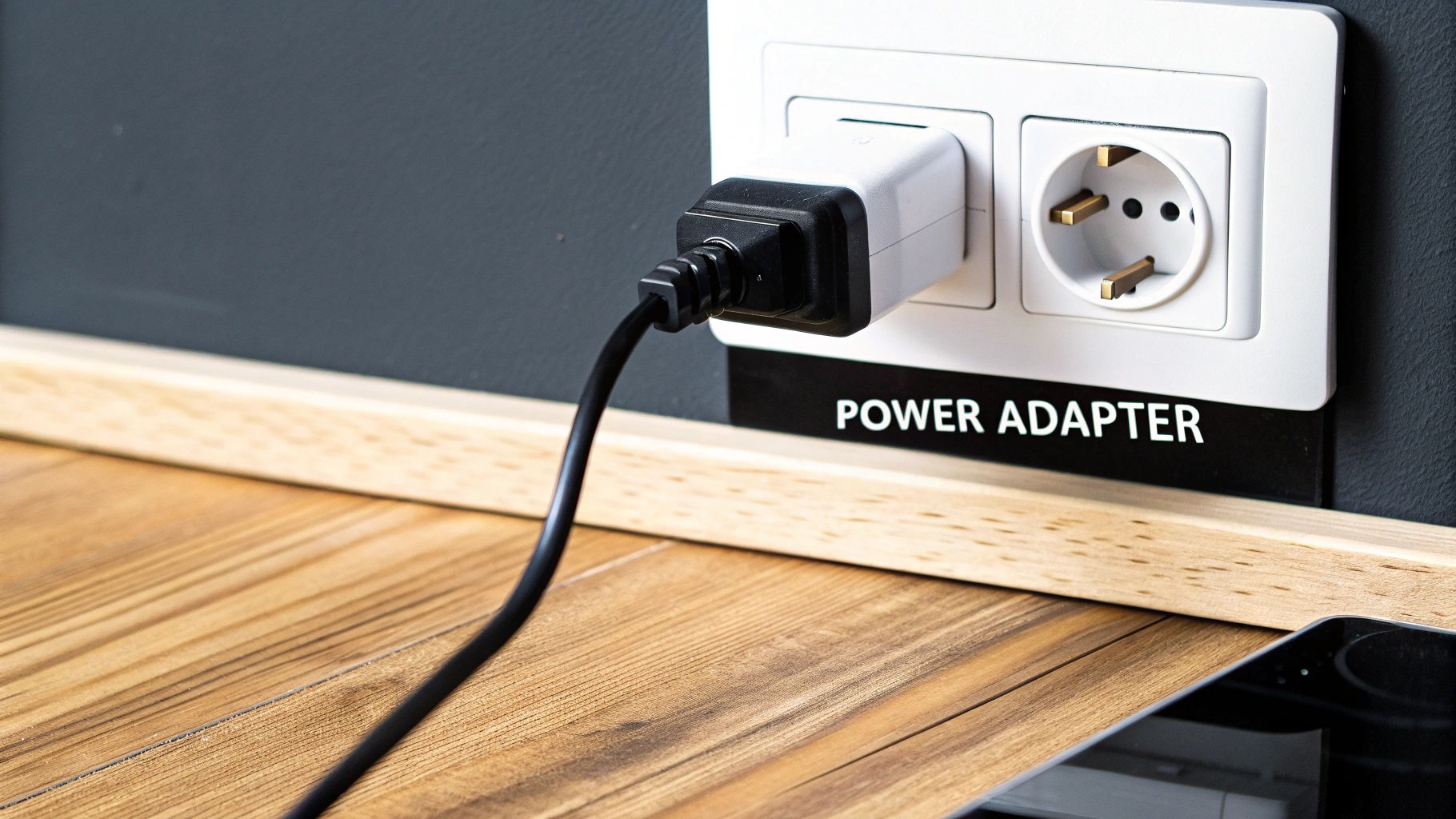
A good universal travel adapter offers compatibility with multiple plug types, including those used in the US, UK, EU, and Australia, making it a versatile tool for globetrotters. Many models also include multiple USB ports, allowing you to charge several devices simultaneously – a huge plus for today’s traveler who relies on multiple electronic devices.
Some adapters even offer surge protection, safeguarding your valuable electronics from voltage fluctuations. Compact and lightweight designs are readily available, making them easy to slip into your luggage without adding bulk.
Why a Universal Adapter Deserves a Spot in Your Luggage: For those building a packing checklist for Europe, this item sits near the top. Whether you’re an independent solo traveler exploring hidden gems, a female traveler relying on your phone for safety and communication, an adventure seeker documenting your hikes and excursions, a culture enthusiast capturing the beauty of historic sites, or a budget-conscious explorer relying on free Wi-Fi to stay connected, a universal adapter is crucial for keeping your devices powered up and ready to go.
Pros:
- Eliminates the need to carry multiple single-country adapters.
- Saves space and weight in your luggage.
- Can charge multiple devices simultaneously with integrated USB ports.
- Usable worldwide, making it a worthwhile investment for future trips beyond Europe.
Cons:
- May not work with high-wattage devices like hair dryers or curling irons. Check the adapter’s specifications before use.
- Quality varies significantly between brands; invest in a reputable brand for reliability and safety.
- Can be bulkier than single-country adapters, though compact options are available.
- Better models with more features (like surge protection) tend to be more expensive.
Examples of Popular Adapters:
- EPICKA Universal Travel Adapter: Covers over 150 countries and is known for its broad compatibility.
- Skross World Adapter Pro+: Features USB ports and a country slider system for easy selection of the correct plug configuration.
Tips for Using a Universal Travel Adapter:
- Dual Voltage Check: Ensure your electronics are dual voltage (110-240V) to avoid the need for a separate voltage converter. Most modern electronics, like phones and laptops, already are.
- Check Accommodation Amenities: Some accommodations provide USB charging stations, which could reduce your reliance on the adapter’s USB ports.
- Built-in Fuse: Consider models with built-in fuses for added safety and protection.
- Carry-On Essential: Pack your universal travel adapter in your carry-on luggage to ensure you have access to it throughout your journey, including during layovers.
2. Packing Cubes
Packing cubes are essential for any packing checklist for Europe, especially if you’re planning on moving between cities or countries. These lightweight fabric containers are designed to organize and compress clothing inside your luggage. They transform the packing experience by compartmentalizing items, making it easier to find specific pieces without unpacking everything.
This efficient system allows for maximum use of limited suitcase space, a critical factor when navigating cobblestone streets and utilizing budget airlines with strict baggage allowances.
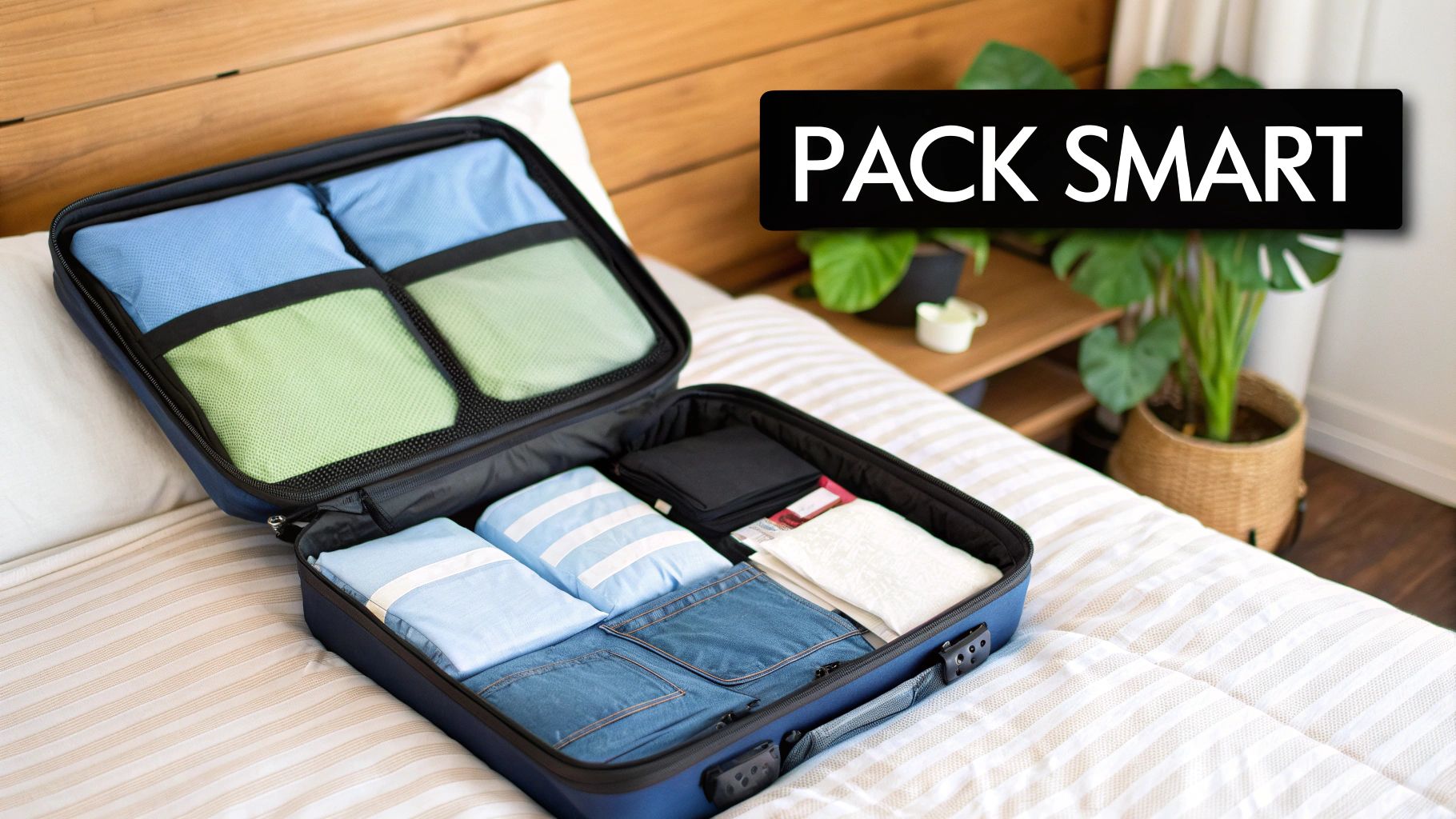
Packing cubes come in various sizes to accommodate different clothing types and are usually made from durable, lightweight fabrics like nylon or polyester. Most feature mesh tops for visibility and ventilation, and zippered closures to keep everything secure. Some even offer compression functionality for further space saving. This makes them perfect for everything from backpacking across the continent to embarking on a Mediterranean cruise.
Why Packing Cubes Deserve a Spot on Your Packing Checklist for Europe:
For independent travelers, especially women navigating solo trips, packing cubes offer an added layer of organization and security. Knowing exactly where everything is located reduces stress and allows for quick access to essential items. For adventure seekers undertaking hikes or outdoor excursions, packing cubes can separate clean clothes from dirty gear, preventing cross-contamination.
Culture and history enthusiasts hopping between museums and historical sites will appreciate the ease of repacking and the minimized wrinkles in their clothes. And for the budget-conscious traveler, maximizing luggage space might mean avoiding checked baggage fees, making packing cubes a valuable investment.
Pros:
- Maximize luggage space: Rolling clothes and using packing cubes can significantly increase the amount you can pack.
- Keep clothes wrinkle-free and compressed: This is especially beneficial for business travelers or those attending special events.
- Simplify unpacking and repacking: No more rummaging through a messy suitcase in your hostel dorm!
- Separate clean clothes from dirty: Essential for longer trips and adventure travel.
- Reduce stress: Staying organized contributes to a more relaxed travel experience.
Cons:
- Add slight additional weight: While lightweight, they do add a small amount of weight to your luggage.
- Quality sets can be expensive: Investing in durable cubes is recommended, but it can be a cost factor.
- Take up space even when empty: While minimal, this is a consideration.
- May not fit perfectly in all luggage shapes: Consider your luggage type when selecting cube sizes.
Examples and Tips for Using Packing Cubes:
- Color-coding: Use different colored cubes for different clothing categories (tops, bottoms, underwear) or for different family members.
- Rolling vs. Folding: Rolling clothes instead of folding maximizes space and minimizes wrinkles.
- Overnight Essentials: Pack one cube with toiletries and a change of clothes easily accessible for overnight stops.
- Dirty Laundry: Designate a specific cube for dirty laundry.
- Compression Cubes: Utilize compression cubes for bulkier items like sweaters and jackets, particularly beneficial for those long European winters.
Popular brands like Eagle Creek Pack-It Specter (known for their ultralight design) and Peak Design (featuring compression zippers) are frequently recommended by travel experts like Rick Steves, who emphasizes packing light for European travel. Amazon Basics also offers a more budget-friendly option.
3. Document Organizer with RFID Protection
A crucial item for any European packing checklist, especially for those prioritizing safety and organization, is a document organizer with RFID protection. This specialized wallet or pouch is designed to keep your important travel documents secure, organized, and protected from electronic theft. With Europe’s bustling cities and frequent border crossings, a document organizer is invaluable for keeping everything in order and reducing the risk of losing vital items or falling prey to data skimming.
How It Works:
These organizers utilize RFID-blocking material. RFID (Radio-Frequency Identification) chips are embedded in passports and many credit cards. Thieves can use scanners to steal information from these chips wirelessly. The RFID-blocking material in the organizer creates a barrier, preventing unauthorized access to your data. The organizer itself provides compartments for your passport, boarding passes, ID cards, and even different currencies, all while maintaining a slim profile suitable for wearing under clothing or carrying discreetly in your day bag.
Why It Deserves a Place on Your Packing Checklist for Europe:
Europe is a hub for international travel, meaning higher chances of encountering pickpockets and electronic theft. Having your essential documents organized and protected in one place offers peace of mind and simplifies travel logistics. It’s especially relevant for solo travelers, female travelers concerned about safety, and budget-conscious explorers who can’t afford to replace lost or stolen documents. The added security and organization make it well worth the small investment.
Features and Benefits:
- Multiple Compartments: Dedicated slots for passport, boarding passes, ID cards, and various currencies make it easy to find what you need quickly. This is particularly helpful when navigating multiple European countries with different currencies.
- RFID-Blocking Technology: The core feature, protecting your sensitive data from electronic theft.
- Water-Resistant Construction: Safeguards your documents from accidental spills or rain.
- Secure Closures: Zippers or Velcro keep everything securely contained.
- Slim Profile: Comfortable to wear under clothing or easily fits into a day bag.
- Hands-Free Carrying: Many designs include neck straps or belt loops for added convenience.
Pros and Cons:
- Pros: Keeps all essentials secure, prevents electronic theft, organizes different currencies, reduces travel stress, often includes hands-free carrying options.
- Cons: Can be bulky if overpacked, quality varies between brands, may be uncomfortable in hot weather, some designs may look like travel wallets attracting unwanted attention.
Examples:
- Zero Grid Travel Wallet: A popular choice among frequent European travelers for its durability and organization.
- Pacsafe RFID-blocking Neck Wallet: Favored by security-conscious travelers for its discreet under-clothing design.
Actionable Tips:
- Include photocopies of your passport and travel insurance within the organizer.
- Store digital backup copies in cloud storage or email.
- Keep emergency contact information visible inside the organizer.
- Separate everyday spending money from your main cash supply within the organizer.
- Consider including a small pen for filling out customs forms.
Popularized By:
Brands like Pacsafe, Zero Grid, and Lewis N. Clark, along with travel security experts focused on European travel safety, have highlighted the importance of RFID-blocking document organizers. This has made them a standard recommendation for packing checklists for Europe.
4. Packable Daypack
A crucial item for any European packing checklist is the packable daypack. This lightweight, collapsible backpack is a game-changer for daily excursions once you’ve arrived and settled into your accommodation. It allows you to explore cities, museums, markets, or even embark on day hikes without the burden of your larger luggage. When not in use, it folds into a compact pouch, taking up minimal space in your suitcase during transit. This is essential for maximizing space and staying organized, particularly for budget airlines with strict baggage limits.
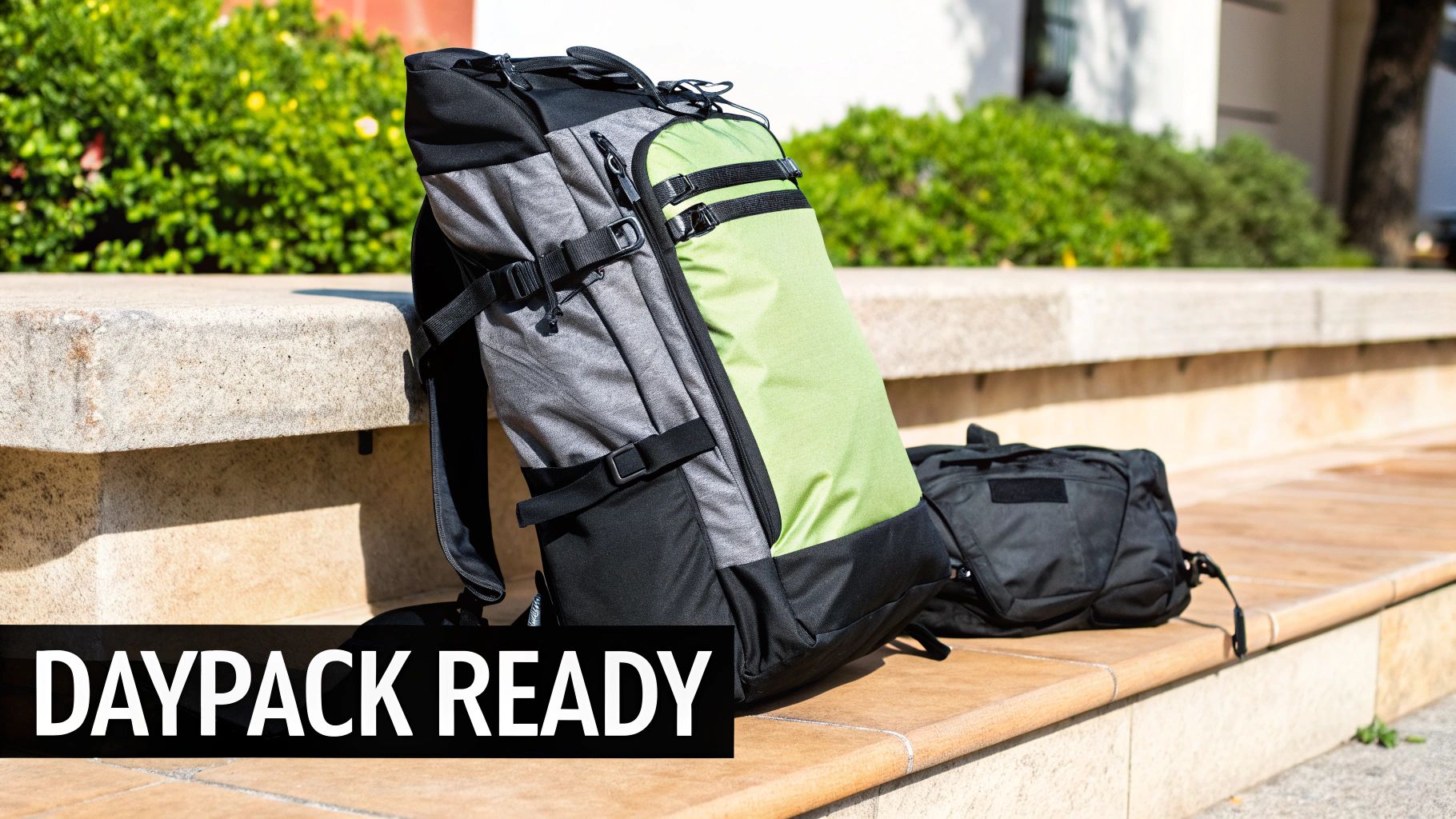
Packable daypacks are typically made from ultralight materials like ripstop nylon, making them both durable and easy to carry. Look for features such as water resistance—essential for unpredictable European weather—multiple compartments for organization, and comfortable straps, even with the minimalist design.
A good packable daypack will have at least one external water bottle pocket and internal zippered pockets for securing valuables. This is especially important for solo female travelers and anyone concerned about pickpocketing in crowded tourist areas.
The advantages of a packable daypack are numerous. It frees you from lugging a full-sized backpack throughout your entire trip, making city exploration much more enjoyable. It’s perfect for carrying essentials like water, snacks, a guidebook, and small purchases from local markets. Furthermore, if your main luggage becomes full of souvenirs, a packable daypack provides valuable extra space for the journey home.
Adventure seekers will appreciate its utility for day hikes and other outdoor excursions. Culture and history enthusiasts will find it convenient for carrying museum guides and other materials. For the budget-conscious traveler, a packable daypack avoids checked baggage fees by allowing you to maximize carry-on space.
While packable daypacks offer excellent convenience, they do have some limitations. They offer less padding and support than traditional backpacks, making them less suitable for carrying heavy loads or for extended trekking. Durability is also a consideration; while made of robust materials, they are generally less durable than their non-packable counterparts. They also have a smaller capacity than standard daypacks and fewer security features compared to travel-specific bags.
Popular brands like Osprey, Sea to Summit, REI Co-op, and Matador offer a variety of packable daypacks suitable for European travel. The Osprey Ultralight Stuff Pack is a favorite among backpackers, while the REI Co-op Flash 18 Pack is known for its versatility in variable weather conditions. Travel guru Rick Steves also highly recommends packable daypacks for European adventures in his guidebooks.
Before purchasing, test the comfort of the straps and consider choosing a neutral color that won’t make you stand out as a tourist, a useful tip for enhancing safety and blending in with the locals. By including a packable daypack on your packing checklist for Europe, you’ll ensure a comfortable and convenient way to explore all that this diverse continent has to offer.
5. Microfiber Quick-Dry Travel Towel
A microfiber quick-dry travel towel is an essential item for any European packing checklist, especially for budget-conscious travelers, hostel-hoppers, and adventure seekers. These compact, lightweight towels are designed to dry significantly faster than traditional cotton towels, making them perfect for life on the go. This is crucial when you’re moving between destinations, staying in various accommodations, or participating in activities where you’ll need a towel that dries quickly.
Why it deserves a spot on your packing checklist for Europe: Many European budget accommodations, including hostels and some vacation rentals, don’t provide towels or charge extra for them. Carrying your own eliminates these unexpected costs and ensures you always have a clean, dry towel available. They’re also invaluable for beach trips, thermal baths, hiking excursions, or even unexpected emergencies where you might get wet.
Features and Benefits:
- Ultra-absorbent microfiber material: These towels efficiently soak up water despite their thin profile.
- Rapid drying: They dry up to 10 times faster than cotton towels, reducing the chance of mildew and that damp towel smell.
- Compact and lightweight: Microfiber towels fold down to a fraction of the size of a standard cotton towel, saving valuable space and weight in your luggage.
- Antimicrobial treatments: Many microfiber towels are treated with antimicrobial agents to prevent odors and bacterial growth, crucial for longer trips.
- Carrying case/hanging loop: Most come with a carrying case or hanging loop for easy storage and drying.
Pros:
- Saves significant space and weight in your luggage.
- Can be packed even when slightly damp in emergency situations.
- Versatile for beaches, pools, hostels, and emergencies.
- Helps avoid towel rental fees in budget accommodations.
- Can double as a picnic blanket, privacy screen, or makeshift curtain.
Cons:
- Different feel compared to plush hotel towels (some describe the texture as less soft).
- Higher quality versions can be more expensive (though still a worthwhile investment in the long run).
- Can develop odors if not dried completely (ensure proper ventilation and drying).
- Some individuals find the texture less pleasant than cotton.
Examples:
- PackTowl Personal: A popular choice amongst the European backpacking community for its durability and absorbency.
- Youphoria Outdoors Microfiber Travel Towel: Favored by budget travelers for its affordability and quick-drying capabilities. Other popular brands include Wise Owl Outfitters and Sea to Summit.
Actionable Tips for Using Your Microfiber Towel:
- Rinse after each use: Rinse your towel thoroughly with clean water after each use to remove dirt, sand, and sunscreen.
- Hang to dry whenever possible: Air drying is the best way to prevent mildew and odors. Utilize the hanging loop if available.
- Choose bright colors: Opt for a bright color to easily distinguish your towel from hostel-provided ones and avoid accidental swaps.
- Medium size (approx. 40″x20″): This size offers a good balance between coverage and packability, making it suitable for most travel needs.
- Look for antimicrobial treatment: Especially for longer trips, an antimicrobial treatment can help prevent odors and keep your towel fresh.
- Consider bringing two: For maximum convenience, especially if you’re planning beach or pool visits, consider packing two: one for showering and one for swimming/outdoor activities.
By packing a microfiber quick-dry travel towel, you’ll be well-prepared for various situations, save space and money, and contribute to sustainable travel practices by reducing laundry needs. It’s a small addition to your luggage with a significant impact on your overall travel experience, particularly for independent solo travelers, female travelers prioritizing efficiency, and budget-conscious explorers seeking to maximize their resources.
6. Multi-Weather Layering System
A multi-weather layering system is essential for any European packing checklist, allowing you to adapt to the continent’s diverse climates – from the sunny Mediterranean beaches to the cool Alpine heights – without overpacking. This strategic approach involves packing versatile, mix-and-match clothing items that can be layered or worn individually, depending on the temperature, precipitation, and your planned activities. This ensures you’re prepared for anything without lugging around excessive baggage.
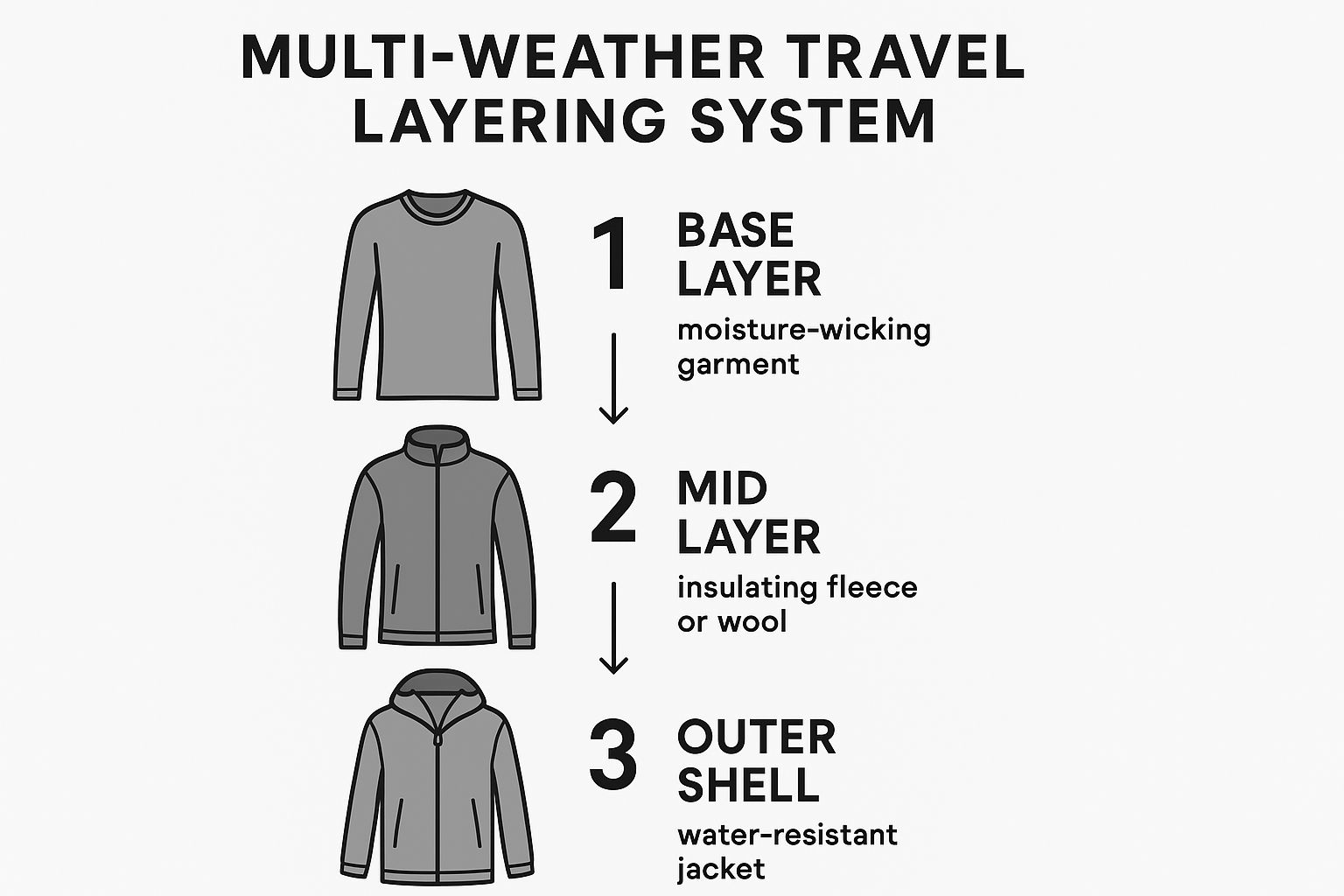
The infographic illustrates the process of building a multi-weather layering system, starting with a moisture-wicking base layer for comfort against your skin, adding an insulating mid-layer for warmth, and finishing with a weather-resistant outer shell to protect against wind and rain. An optional fourth layer, an insulated jacket or vest, provides extra warmth in colder climates. This visual guide emphasizes the adaptability of this system, allowing you to add or remove layers as needed throughout your day.
This system offers significant benefits for various traveler types. Independent solo travelers gain freedom and flexibility by being prepared for spontaneous weather changes. Female travelers prioritizing safety can avoid being caught unprepared in unfamiliar climates. Adventure seekers, from hikers to cruise passengers, can adjust their attire to fluctuating conditions throughout their excursions. Culture and history enthusiasts can comfortably explore both indoor and outdoor attractions. And budget-conscious explorers benefit from the efficiency and reduced luggage costs associated with packing less.
The system typically consists of: moisture-wicking base layers (e.g., merino wool or synthetic fabrics); mid-layers for insulation (e.g., lightweight fleece or a wool sweater); a windproof and water-resistant outer shell (e.g., a packable rain jacket); and, optionally, a packable down or synthetic jacket for colder conditions. Choosing a coordinated color scheme maximizes outfit combinations, further streamlining your packing.
Pros:
- Adaptability to varied European climates.
- Reduced packing volume and increased versatility.
- Easy adjustment throughout the day as temperatures change.
- Simplified decision-making during trips.
- Preparedness without excessive luggage.
Cons:
- Requires planning before your trip.
- Quality technical layers can be expensive.
- May require occasional laundry during longer trips.
- Potentially less variety in outfit choices compared to packing individual outfits.
Examples:
- A classic European travel combination: moisture-wicking t-shirt, light merino sweater, packable rain jacket.
- Systems adopted by frequent European travelers: Patagonia’s Capilene/R1/Nano Puff/Shell combination.
Tips for Implementing a Multi-Weather Layering System for Your Packing Checklist for Europe:
- Choose a neutral color palette with 1-2 accent colors for maximum mix-and-match possibilities.
- Invest in quality merino wool pieces that resist odors and regulate temperature effectively.
- Pack no more than one week of clothing regardless of trip length – you can do laundry along the way.
- Include one packable down/synthetic vest or jacket that compresses small.
- Select a waterproof/breathable shell that can be worn in cities without looking too technical.
The multi-weather layering system has been popularized by brands like Patagonia and Uniqlo (with their HeatTech and Ultra Light Down lines), merino wool brands like Smartwool and Icebreaker, European travel expert Rick Steves’ packing philosophy, and the ‘capsule wardrobe’ concept adapted for travel. By adopting this method, you’ll not only pack lighter but also be prepared for whatever weather Europe throws your way, ensuring a more comfortable and enjoyable trip.
7. Digital Luggage Scale: Conquer European Budget Airline Fees
When crafting your packing checklist for Europe, especially if you plan on flying with budget airlines, a digital luggage scale deserves a prime spot. This small but mighty tool can save you from hefty excess baggage fees, a common travel woe, particularly with carriers like Ryanair, EasyJet, and Vueling. These airlines are known for their strict and often expensive baggage policies, sometimes exceeding €50 per kilogram over the limit. A digital luggage scale empowers you to take control of your luggage weight and avoid unpleasant surprises at the airport.
This compact, handheld device weighs your luggage before you even arrive at the airport. It provides accurate weight measurements, typically within 0.1-0.2 pounds or kilograms, offering a far more precise reading than your bathroom scale. Models usually feature a digital display showing both pounds and kilograms, an ergonomic design for easy lifting, and an auto-shutoff function to conserve battery life. Most can handle weights up to 50kg/110lbs, more than sufficient for even the most enthusiastic souvenir shopper.
Why This is Essential for Your European Adventure:
For budget-conscious explorers, avoiding excess baggage fees is crucial for keeping trip costs down. Imagine being able to confidently navigate the check-in counter, knowing you’re within the weight limits. This allows you to allocate your travel budget to experiences, not penalties. Independent solo travelers, particularly female travelers prioritizing safety, will appreciate the freedom and peace of mind this provides. No more frantic repacking at the airport or abandoning cherished souvenirs.
Real-World Examples:
Think of a traveler using an Etekcity Digital Luggage Scale to meticulously ensure their bag meets Ryanair’s strict 20kg limit, or a shopper using a Dr. Meter Electronic Balance to track souvenir weight accumulation and stay within budget. These scenarios highlight the practical benefits of this simple device.
Actionable Tips for Using a Digital Luggage Scale:
- Weigh After Packing and Before Each Flight: This is especially important if you’re traveling on multiple airlines with varying baggage allowances.
- Know the Limits: European budget airlines often have lower weight limits than major carriers. Research your airline’s specific policy beforehand.
- Souvenir Savvy: Use the scale to weigh souvenirs before purchasing to gauge their impact on your overall luggage weight.
- Battery Check: Before your trip, check the batteries (usually watch/button cell type) to ensure the scale is functional.
- Consider Multi-Functionality: Some models include a built-in measuring tape, helpful for checking carry-on dimensions.
Pros & Cons:
Pros:
- Prevents expensive excess baggage fees.
- Allows for redistribution of items between bags before reaching the airport.
- Enforces self-discipline when shopping for souvenirs.
- More accurate than bathroom scales for luggage weight.
- Takes minimal space in your luggage.
Cons:
- Requires batteries.
- Another item to remember to pack.
- Some models may have accuracy issues (choose a reputable brand).
- Limited functionality beyond weighing luggage.
By including a digital luggage scale in your packing checklist for Europe, you’ll be well-equipped to handle the strict baggage policies of budget airlines, enjoy stress-free travel, and focus on what truly matters: experiencing the wonders of Europe.
7-Item Packing Essentials Comparison
| Item | 🔄 Implementation Complexity | ⚡ Resource Requirements | ⭐ Expected Outcomes | 💡 Ideal Use Cases | 📊 Key Advantages |
|---|---|---|---|---|---|
| Universal Travel Adapter | Low – plug-and-play device | Low – requires purchase, no power source | High – enables device compatibility across regions | Frequent international travelers, multi-country trips | Versatile worldwide use, multiple device charging, compact |
| Packing Cubes | Low – simple packing technique | Low – purchase of fabric cubes | High – better luggage organization and space saving | Organized packers, multi-city travels | Maximizes luggage space, keeps clothes wrinkle-free |
| Document Organizer with RFID Protection | Low – no setup, just use | Low – pouch/wallet with RFID-blocking | High – secures sensitive travel documents | Security-conscious travelers, frequent border crossings | Protects against electronic theft, document organization |
| Packable Daypack | Low – ready-to-use bag | Low – lightweight backpack | Medium – convenient daily use and extra storage | Day trips, city exploration | Ultralight, compressible, saves luggage space |
| Microfiber Quick-Dry Travel Towel | Low – simple use and pack | Low – purchase of towel | High – fast drying and lightweight | Hostels, beaches, active travel | Saves luggage weight/space, versatile multipurpose use |
| Multi-Weather Layering System | Medium – requires planning | Medium – investment in quality clothing | High – versatile outfit adaptability | Variable European climates, long duration trips | Reduces bulk, adaptable to weather, odor-resistant layers |
| Digital Luggage Scale | Low – straightforward device | Low – device plus batteries | High – avoids overweight fees at airports | Budget airline travelers, multi-flight itineraries | Accurate weight check, portable, reduces extra fees |
Ready to Pack Your Bags?
With this comprehensive packing checklist for Europe, you’re well on your way to a seamless and enriching travel experience. From essential items like a universal travel adapter and RFID-blocking document organizer for safety and practicality, to packing cubes and a packable daypack for maximizing space and staying organized, every item on this list contributes to a smoother, more enjoyable journey. Remember, efficient packing isn’t just about minimizing luggage weight; it’s about maximizing your freedom and minimizing stress so you can focus on what truly matters: immersing yourself in the culture, history, and adventure that awaits you in Europe.
Whether you’re an adventure seeker tackling challenging hikes, a culture enthusiast exploring ancient ruins, or a budget-conscious traveler making the most of every euro, mastering these packing essentials will empower you to embrace the spontaneity and wonder of independent travel. This packing checklist for Europe is your foundation for creating unforgettable memories.
Ready to take the next step in planning your European adventure? Discover more essential travel tips, destination guides, and solo travel resources tailored to your interests at gotravelyourself.com. We offer invaluable insights and community connections to empower your solo journey across Europe and beyond.

Hi, I’m Lily, a travel writer based in the UK who loves exploring everything from familiar hometown gems to the varied landscapes across Europe. Whether I’m strolling through charming coastal villages or hopping trains across the continent, I’m always on the lookout for authentic, unexpected stories and experiences.
My writing style is simple and relatable—think no-fuss guides to finding the best pasty in Cornwall or stress-free tips for getting around European cities. If there’s a great view, tasty food, or a bit of history involved, chances are I’m already scribbling notes about it.

